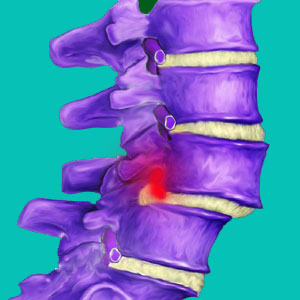
Does spondylolisthesis cause herniated discs? Many patients who have been diagnosed with listhesis and some variety of disc abnormality want to know the answer to this important question. We have been researching the link between spondylolisthesis and bulging discs for more than a decade. We are confident that a relationship can exist in both the causation of the disc condition, as well as its symptomatic activity.
This crucial essay focuses on the collateral effects of spinal listhesis on the intervertebral discs. We will examine how spondylolisthesis might relate to the development of degenerated discs, bulging discs and ruptured discs, using evidence gathered over an extensive timeline of clinical practice and patient citations. If you are interested in the manner by which spondylolisthesis might play a role in the development of intervertebral herniations, then this article is made just for you.
Does Spondylolisthesis Cause Herniated Discs or Not?
For those who do not know, spondylolisthesis, also sometimes simply called listhesis, is a spinal abnormality involving the abnormal shifting of one or more vertebral bones anteriorly or posteriorly in the vertebral column. Forward displacement of a vertebral bone in relation to the remainder of the spine is technically known as anterolisthesis, while rearward migration of a vertebral bone is called retrolisthesis.
Spondylolisthesis is most commonly seen at L5 in the lumbar spine. This is the classic presentation. However, the condition can affect virtually any bone in the spine and is also often demonstrated at L4, at a transitional L6 or in any of the mid to lower cervical vertebrae between C5 and T1.
Listhesis is graded with the degree of slippage being the determining factor in its clinical severity. Since vertebral overlap can be seen clearly on virtually any type of advanced imaging, it is easy to grade most spondylolisthesis diagnoses easily and accurately one a rating scale from 1 (mildest) to 4 (most clinically significant).
As a reminder, disc abnormalities in the spine are considered normal, commonplace, mostly asymptomatic and virtually universal in some locations, such as L4/L5 and L5/S1. These structural changes are normal parts of aging and activity, but it is well known that many factors can influence the incidence of herniations, the age of onset and the symptomatic activity associated with the disc change. Spondylolisthesis is certainly one of these conditions.
How Does Spondylolisthesis Cause Herniated Discs?
Intervertebral discs are attached to the vertebrae above and below by cartilaginous endplates. These are simply tissues that bond the disc to the spinal bones surrounding it, preventing it from slipping out of position on the spine. The very misleading laymen’s diagnostic term “slipped disc” has some patients believing that the spinal discs can actually have the capacity to move out of place, which is completely untrue. These discs are firmly fastened and will not ever “slip”. The cartilaginous endplates also offer support for the disc by providing neurological activity and nutrition for the disc, since it has no internal nerve or circulatory tissues of its own.
It is important to be able to visualize the disc being attached to the bones above and below it. The disc is designed to sit comfortably between these bony surfaces like the filling of a sandwich cookie. If each cookie surface is in perfect alignment, the filling is safely and symmetrically contained. Now, let’s add spondylolisthesis to the mix an see how this changes the imaginary cookie. Let’s imagine the top half of the cookie sliding forward and out of alignment with the bottom half of the cookie. What happens to the filling? Well, some sticks to the top half, while some sticks to the bottom half. Some even falls out of the cookie altogether, since it has nothing to firmly bond onto. This is the exact thing that can happen to intervertebral discs when spondylolisthesis occurs.
The above example is a gross oversimplification, but is very effective for getting people to imagine what is occurring in the spine when listhesis is present. The disc will be stretched and elongated, trying to keep its strong bond with both the top and bottom vertebral bones. Parts of the disc will no longer be protected on the top or the bottom, since they will extend over the edges of the respective vertebral bones. Also, the disc will be stretched asymmetrically, with the top vertebra pulling hard on some parts of the annulus fibrosus, while the bottom vertebral bone will pull on other parts of the outer disc wall. The result is chronic stress on the annulus fibrosus, exponentially escalating the already considerable forces it must contend with from normal movement of the spine. This chronic stress can lead to accelerated deterioration, desiccation and breakdown of the disc wall, resulting in degeneration, bulging, herniation or rupture of the tissue.
Does All Spondylolisthesis Cause Herniated Discs?
Minor versions of spondylolisthesis are unlikely to have major consequences on the intervertebral disc tissue nearby. Luckily, mild cases account for the vast majority of patients profiles. Some mildly increased stress will be exerted on the disc, but probably not enough to make a significant difference in the age of degeneration, herniation or symptoms, if any will eventually begin. Remember, herniations are completely normal in a perfectly typical spine with no structural abnormality in vertebral alignment.
When spondylolisthesis is more clinical significant, the chances of it affecting the “sandwiched” disc are much higher. In cases of considerable slippage (which can actually exceed 100%), the disc is literally being stretched to its limits of endurance and will likely falter under the extreme stress. This is why intervertebral degeneration and herniation is so commonly seen in surrounding levels to imaged severe spondylolisthesis.
It is vital to remember that the tissues of the annulus and nucleus are designed to expand and contract as normal parts of their functionality. It is also crucial to know that eventually, disc tissues will desiccate and suffer deterioration in any spine. However, severe cases of listhesis can hasten this process, make it more dramatic than in a typical spine and can also set up additional possible symptomatic mechanisms due to the vertebral migration.
For more information on the relationship between herniated discs and listhesis, please speak to your orthopedist. You can also read much more about vertebral migration on our dedicated spondylolisthesis website.
Herniated Disc > Causes of a Herniated Disc > Does Spondylolisthesis Cause Herniated Discs





